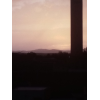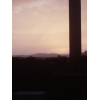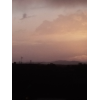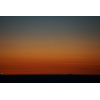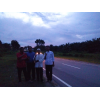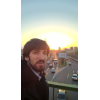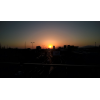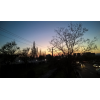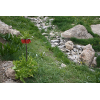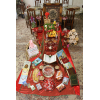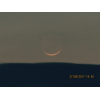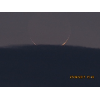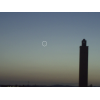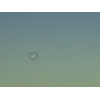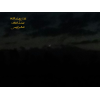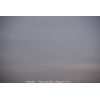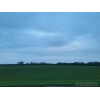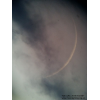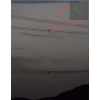Visibility of Sha'ban Crescent 1438 AH
- When to Observe Sha'ban Waxing (NEW) Crescent ?
- Sha'ban Waxing (NEW) Crescent Observation Results
- The OFFICIAL First Day in Different Countries
- When to Observe Rajab Waning (OLD) Crescent ?
- Rajab Waning (OLD) Crescent Observation Results
When to Observe Sha'ban Waxing (NEW) Crescent ?
The geocentric conjunction (Geocentric New Moon) will occur Inshalla on (Wedensday 26 April 2017) at 12:16 UT.
Sighting the new crescent on (Wedensday 26 April 2017) and (Thursday 27 April 2017) is shown in the below graphs using the program Accurate Times by Mohammad Odeh according to Odeh criterion. Where:-
- It is impossible to see the crescent from the areas located under the red color. Because either the Moon on this day sets before the Sunset and/or the topocentric conjunction occurs after the Sunset.
- The crescent is expected to be seen by optical aid only from the areas located under the blue color.
- The crescent is expected to be seen by optical aid from the areas located under the magenta color. In these areas the crescent could be seen by naked eye if the atmospheric conditions are superb and the observer is experienced.
- The crescent is expected to be easily visible by naked eye from the areas located under the green color.
- The crescent cannot be seen from uncolored areas, even though the Moon sets in these locations after the Sunset and the topocentric conjunction occurs before the Sunset, but the Moon is not sufficiently illuminated in order to be seen as crescent even by optical aid.
- Kindly notice that the below graph shows the possibility of seeing the crescent from areas between 60 degrees north of Equator down to 60 degrees south of Equator.
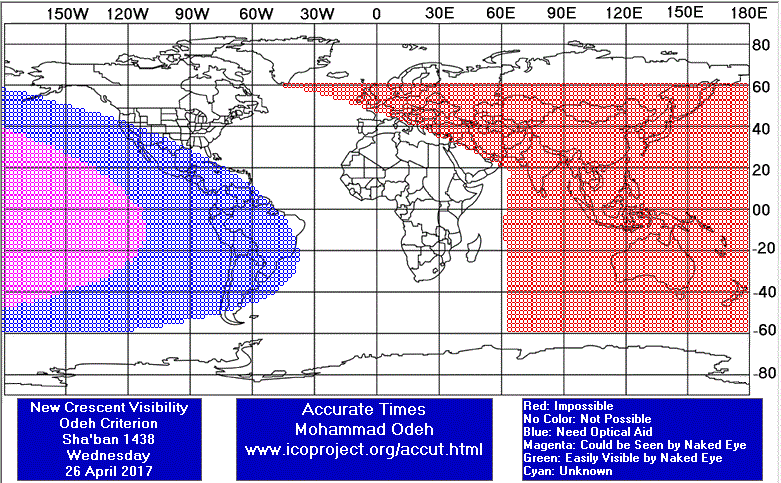
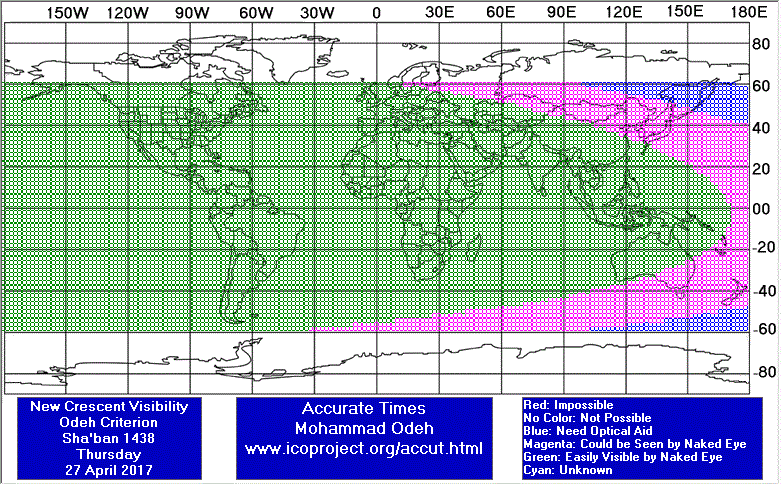
According to the Universal Hejric Calendar (UHC), which is based on the calculated crescent visibility, the start of this month in the Eastern Region will be on Friday 28 April 2017 and in the Western Region will be on Thursday 27 April 2017. Kindly notice that the UHC is a pre-calculated calendar, which adopts a certain criterion to start the new Hejric month. Your country/organization might adopt different criterion to start the new Hejric month. So it is highly advised to read the UHC website before giving any judgment.
- Results of seeing the crescent, and the first day of the month in different countries will be added here Inshalla as we receive the reports from ICOP's members. If you wish to be a member in ICOP, or to know more about it, kindly click here.
Sha'ban Waxing (NEW) Crescent Observation Results
Wed 26 April 2017
Morocco
Mr. Walid Jadar said: "اليوم هو ليس يوم التحرى في المملكة المغربية "
United States
Dr. John Caldwell said: "Most of sky clear. Striated cloudiness along W horiz."
Thu 27 April 2017
Australia
Bangladesh
Mr. ABM Ruhul Hassan said: "Eventually we have seen the Shaban crescent in the northern part of the country,Thakurgoan. Our best time calculation was 6:51 minute (Dhaka Time). After adding + 13 minute (Thakurgoan time difference) we have got information and verified around 7:15. We are very lucky today. Islamic Foundation declared the date based on our sighting report."
Indonesia
Mr. AR Sugeng Riyadi said: "I tried to observe the new crescent of Sha'ban 1438 AH on Thursday 27 April 2017 with my friends at Pangkalan Lada Kota Waringin Barat Central Borneo (The Kaukaba Team). The moon was not sighted because all sky was cloudy."
Iran
Mr. Hossein Janghorbani said: "Mr.Reza Janghorbani based in the city of Tabriz in East Azerbaijan province Moon Crescent At 20:12 is observed with the 15*70 binoculars and Moon Crescent At 20:20 is observed with the naked eye."
Mr. Hossein Janghorbani said: "In the name of God Happy new Years (Jalali Hosseini 14396 - In accordance with Serolaajaeb calendar, The Astronomy and Geophysics Center of Shahreza) Sha'ban Crescent Observation Report The Astronomy and Geophysics Center of Shahreza – The Crescent Association of Shahreza Report by: Hossein Janghorbani (Najmosepehr-Sadrolmonajjemin) – Manager of Shahreza Crescent Association and Red Crescent’s Astronomy and Geophysics Center Date: Thursday, 04/27/2017 Location: Mountain Shenly Dehaghan(Boodjan) in the Southwest of Shahreza (latitude: 31 50 N, longitude: 51 35 E, elevation: 2570m from sea level, time zone: +4.5 GMT) Equipments: One sets of 15*70 binoculars, One sets of 20*90 binoculars, One sets of 7*50 binoculars, One compass. Atmospheric condition: partly cloudy in western horizon. Horizon obstacles: 2/5° Apparent sunset: ..:.. Results: Moon crescent was not seen. Observers: 1- Zohreh Karimpoor 2- Narges Shahnazari 3- Azam Erfan 4- Sakineh Moosavi 5- Toktam Aliabedi 6- Soheyla Eslami 7- Shiva Ansaripoor 8- Masoomeh Hafar 9- Ziba Hafar 10- Dr Ali Akbar Taki 11- Mohammad Javad Nikeghbal 12- Azam Shojaee 13- Shahideh Torabi 14- Alireza Torabi 15- Saer Aliabedi 16- Mahdi Ghasemi 17- Hossein Janghorbani 18- Ali Janghorbani 19- Zahra Fallahi 20- Parvin Rezaee 21- Mohammad Sadra Nikeghbal 22- Mohammad Javad Hafar 23- Maryam Nazem 24- Elaheh Khodadipoor 25- Pooya Hafar 26- Faezeh Nazem 27- Abdolreza Gholami 28- Shahriar Gholami 29- Talaat Taheri 30- Tayebeh Shafiee 31- Behnaz maarefvand 32- Zohreh Salek 33.Reyhaneh Dadvand "
Malaysia
Morocco
Oman
Prof. Mohammed Al-Bussaidi said: "الجو مغبر قليل وتمت رؤية الهلال بالمنظار وبالكاميرا "
Mr. Fahad Fadhil said: "تمت الرؤية بحمد الله تعالى من قبل الفريق الميداني لتحري الأهلة بمحافظة ظفار ، كما أن الهلال رؤي بالعين المجردة بسهولة من فوق الجبال بشهادة بعض سكان المناطق الجبلية نظرا لطول مكثه وارتفاعه."
Saudi Arabia
Mr. Turki Alamri said: "The sky condition was too bad after sunset despite of that we managed to see the new crescent by naked eye but we could not see the structure very well , at the beginning we used a binocular to determine the exact crescent "
South Africa
Dr. Abdurrazak Ebrahim said: "1438 H Shabaan Hilaal seen by naked eye in many parts of Southern Africa. The 1st of Shabaan will correspond to Friday, 28 April 2017."
Sri Lanka
Mr. Abdul Rahman Razeen said: "Aalaikum. Today 27-04-2017CE=29-07-1438AH is the sighting day for the month of Shaban 1438AH in Srilanka. I was in Colombo Grand Mosque.The sky was partly cloudy in Colombo. The parameters are Sun set:6:19pm. Moon set:7:20pm. Lag=61minutes The prediction of the astronomers=Crescent can be sighted easily. Hilaal sighting groups was arranged right round the country. Positive sighting reports was recieved to CGM Hilaal Committee from west coast of Srilanka first from Puttalam at 6:40pm and then from Jaffna,Bambalapitiya and Galle. The orientation was 3-7 o'clock. Hence it was decided at the Hilaal Committee conference at CGM which was presided by the CGMH Committee president Moulana Riyadh (Baari) along with ACJU and MRCA to complete the proceeding month as 29 days and start the month of Shaban on 28-4-2017CE."
United Kingdom
Eng. Qamar Uddin said: "The Hilal of Shaban 1438 was sighted in the UK in many places, including at the York Astronomical Society Observatory by Qamar Uddin, Aqeal Peero, Yusuf Neto and two others at 20:51 hrs BST with 10x70 binoculars and 20:55 hrs BST by naked eye (through breaks in the clouds), Alhamdulillah. The photos below are cloudy before sunset, breaks in cloud after sunset and then out-pops the hilal for few seconds."
United States
Dr. Javad Torabinejad said: "I arrived at my sighting location (the Blacksburg Middle School) at 8:57 pm EDT (sunset: 8:07 pm). I started looking for the moon in a mostly cloudy western horizon. My first naked-eye sighting was at 9:03 pm when the moon appeared in a small clearing. I observed it for a short time before leaving the site prior to moonset (moonset: 9:39 pm). The crescent was easy to see with its horns at 2:00 and 7:00 O'clock (2:00;4:30;7:00)."
The OFFICIAL First Day in Different Countries
Thu 27 April 2017
1 . Bahrain
2 . Kuwait
3 . Qatar
Fri 28 April 2017
1 . Algeria
2 . Australia
3 . Bangladesh
4 . Egypt
5 . Indonesia
6 . Iran
7 . Jordan
8 . Libya
9 . Malaysia
10 . Morocco
11 . Oman
12 . Pakistan
13 . Palestine
14 . Saudi Arabia
15 . Sri Lanka
16 . Syria
17 . Tunisia
18 . United Arab Emirates
When to Observe Rajab Waning (OLD) Crescent ?
The geocentric conjunction (Geocentric New Moon) will occur Inshalla on (Wedensday 26 April 2017) at 12:16 UT.
Sighting the OLD crescent on (Wedensday 26 April 2017) and (Tuesday 25 April 2017) is shown in the below graphs using the program Accurate Times by Mohammad Odeh according to Odeh criterion. Where:-
- It is impossible to see the OLD crescent from the areas located under the red color. Because either the Moon on this day rises after the Sunrise and/or the topocentric conjunction occurs before the Sunrise.
- The crescent is expected to be seen by optical aid only from the areas located under the blue color.
- The crescent is expected to be seen by optical aid from the areas located under the magenta color. In these areas the crescent could be seen by naked eye if the atmospheric conditions are superb and the observer is experienced.
- The crescent is expected to be easily visible by naked eye from the areas located under the green color.
- The crescent cannot be seen from uncolored areas, even though the Moon rises in these locations before the Sunrise and the topocentric conjunction occurs after the Sunrise, but the Moon is not sufficiently illuminated in order to be seen as crescent even by optical aid.
- Kindly notice that the below graph shows the possibility of seeing the crescent from areas between 60 degrees north of Equator down to 60 degrees south of Equator.
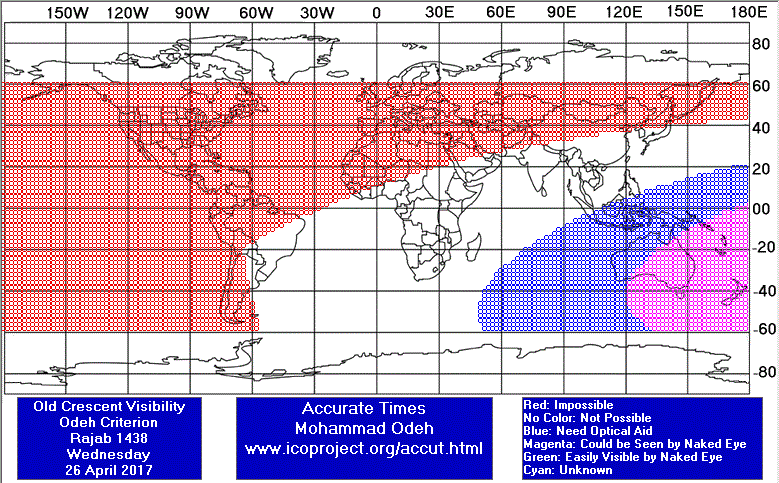
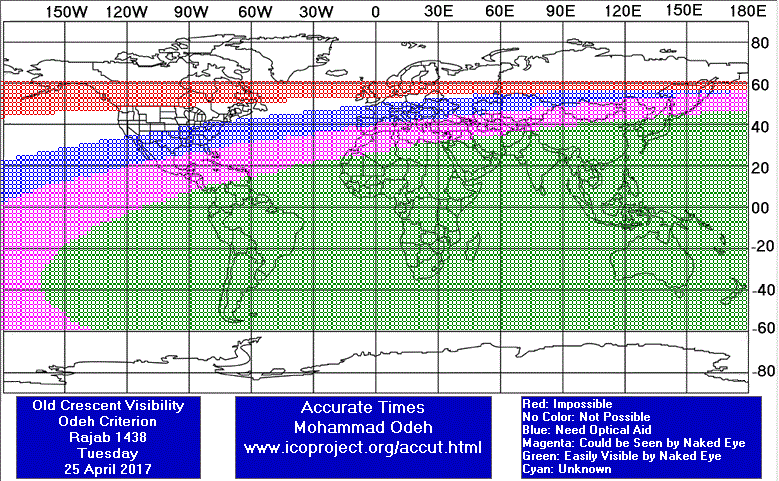
Rajab Waning (OLD) Crescent Observation Results
Tue 25 April 2017
Indonesia
Mr. AR Sugeng Riyadi said: "The waning crescent of Rajab 1438 H was not seen on Tuesday 25 April 2017 from Rowasiya Observatory at Bendo Ketitang Juwiring Klaten Central Java Indonesia. The east horizon was cloudy."
Saudi Arabia
Dr. Ayyub Patel said: "Although partly cloudy easter horizon but the old waning crescent moon for Rajab 1438 was seen by naked eye and by binoculars for about 15 minutes before sunrise. The Ummul Quraa calendar date is 28th Rajab 1438. Clearly it is a day ahead of the regional visibility calendar. for this month of Rajab."
